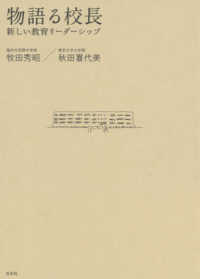- ホーム
- > 洋書
- > 英文書
- > History / World
Full Description
A comprehensive analysis of political violence in Weimar Germany with particular emphasis on the political culture from which it emerged.
"Today's readers, living in what Charles Maier calls 'a new epoch of vanished reassurance', will find this book absorbing and troubling."—The Historian
The Prussian province of Saxony—where the Communist uprising of March 1921 took place and two Combat Leagues (Wehrverbände) were founded (the right-wing Stahlhelm and the Social Democratic Reichsbanner)—is widely recognized as a politically important region in this period of German history. Using a case study of this socially diverse province, this book refutes both the claim that the Bolshevik revolution was the prime cause of violence and the argument that the First World War's all-encompassing "brutalization" doomed post-1918 German political life from the very beginning. The study thus contributes to a view of the Weimar Republic as a state in severe crisis but with alternatives to the Nazi takeover.
From the introduction:
After the phase of civil war, political violence assumed a distinctly limited form. It was no longer aimed at killing or wounding as many opponents as possible; instead, it served political parties and organizations as an instrument for exerting pressure in the struggle over control of the street. This development was driven by the Combat Leagues (Wehrverbände) of all political camps, who, with their uniforms and marches, injected militaristic elements into the political culture. However, since the violence they perpetrated followed a political and not a military logic, it was, as I will show, in principle controllable and did not pose a fundamental threat to the political order, not even in 1932, that particularly turbulent year before Hitler's assumption of power.
Contents
Preface
List of Illustrations and Tables
List of Abbreviations
Note on the administrative structure of Prussia
Introduction
PART I: THE CIRCUMSCRIBED CIVIL WAR 1919-1921
Chapter 1. Radicalization and Violence 1919
Chapter 2. New Mistrust, Old Enemies: The Massive Experience of Violence during the Kapp Putsch of 1920 and its Aftermath
Chapter 3. Preventive Offense and Improvised Uprising: the "March Action" of the Prussian Government and the Communists 1921
PART II: SYMBOLIC FIGHTING AND THE STRUGGLE FOR TERRITORY 1921-1923
Chapter 4. The Political Murders of 1921/1922 and their Consequences in the Province of Saxony
Chapter 5. The Catastrophe that did not Happen: Food Protests and Political Violence under Hyperinflation 1922/1923
PART III: YEARS OF CALM? POLITICAL VIOLENCE 1924-1929
Chapter 6. The Rise of the Combat Leagues (Wehrverbände)
Chapter 7. The Continuity of Violence
Chapter 8. A Parade of Men. Violence in the Political Culture
PART IV: THE ESCALATION OF VIOLENCE: 1929/30-1933
Chapter 9. The Rise of the Nazi Movement and the Persistent Weakness of the Communists
Chapter 10. Escalation without Limits? Political Violence in the Final Phase of the Weimar Republic
Chapter 11. Misjudgment, Downplaying, Approval: Interpretations of Political Violence 1930-1933
Conclusion: Political Violence and the Weimar Republic's Chances of Survival
Bibliography
Subject Index
Index of People and Places








